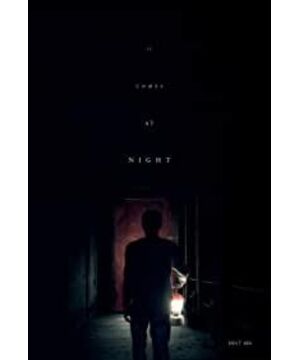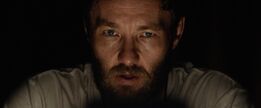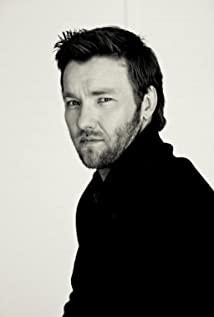The short comment is a bit long and not serious enough. The length is embarrassing.
:
I personally don't like this movie very much
It doesn’t have the original raw stylized get out that it follows. The inherited tradition and regularity of get out, if used for reference, have a little shadow.
The concept of it is borrowed again. It cannot be defined, cannot be prevented, cannot be avoided. It can be an entity or a prototype fear (for the darkness, for the other, for life and future). The door that symbolizes fear, danger, instinct and depravity is essentially a slippery slope of human nature. It seems to foreshadow a certain destiny and ending. Can human beings resist destiny? At the end of the world, can human beings survive on the basis of material superiority regardless of the spiritual world? Orwell and Huxley both asked whether it is possible for human beings to reject/forget dignity and humanity. Is there a search for humanity in the essence of human beings? The son is the narrative center of the whole film. His humanity is placed under a microscope, allowing people to watch the death of his grandfather's dead pet dog. The deaths of other kind and innocent people are his mediation with the pursuit of humanity, which rises to the extreme turning point, and finally collapses and decays. It also heralds the defeat and decline of human nature
Speaking of stylized film language, it is really lackluster. However, in this kind of casual and simple style of avoiding complexity and simplicity, the style of the film has just been shaped. When the leading actor interrogates the intruder Wil tied to a tree, the shots are one-sidedly different. Shults likes to include only relevant/important information in the common omniscience lens, so the head is full of the frame, the lens is skewed and the lens is skewed and the long lens is random instead of jumping. Red promiscuity with many gatherings using the raw material / the repressed yellow and green of the veterinary hospital / the return of humanity / the cold color at the moment of entanglement The bold warm color when eating meat it comes at night Most of the scenes occur indoors with weak lighting, only one that indicates danger The narrow red door and the high brightness outside are flooded with a large area of green, even thick plasma/darkness, health/safety and distortion/danger is clearly divided into queues, intentional but no characteristics
It is also interesting that most of the horror segments are completed in the state of nightmare/consciousness, while the day is an ordinary life scene. In the film, the son always uses dreams to complete things that he can never do. Catharsis of fear, dissatisfaction, sexual impulse, society Motivation for needs and achievement, but the achievement of these goals is often accompanied by a bloody ending-a dilemma of being infected, injured or even killed.
What I don’t like is probably a bit deliberately a little bit hard. Although it is pitiful, it’s too hard-line. I prefer the fragility of it follows and raw. I don’t want to look at this disguised strength. It is said that many film critics have given a high degree to the director’s work Krisha last year. I can find it someday for evaluation
[Supplement the concept of independent horror films/indie horror films/independent horror films]
Indie horror films theoretically belong to the category of independent films, but in the eyes of American scholars and critics, indie horror films are often a part of being isolated and ignored by Jamie Sexton in
One of the reasons for the exclusion was that the definition of independent film in the United States often changed. Independent film was once a film produced under a filming mechanism. The collective name was later turned into a type of independent film. The factors include film production. The company’s investment and most of the contradictory examples given by Sexton is that Gone witht the Wind actually produced it for a little-known studio, but it was released with MGM’s thighs. However, according to the definition of independent film, it is not derived from Films from traditional major studios can all become independent films. Although Gone with the Wind's investment is more than three times the average investment of non-independent films at the time, this is contrary to people's perception that low-cost films are usually classified as independent films.
The author also admits that the inheritance and overlap between art-house and indie movies has also evolved into art-horror films, a variant representative of films such as Dreyer’s Vampyr vampire Georges Franju’s Les Yeux sans visage’s faceless eyes, etc. In line with the art film tradition, slow long mirrors are often used, large spaces and rare dialogues are full of reflection and exploration of consciousness and memory
The Shining is also included in the category of art horror movies
Therefore, it can be concluded here that independent horror movies/art horror movies are the infusion of traditional horror movie elements, such as some long-lasting horror propositions (vampire haunted house, ghosts, etc.), traditional suspense setting methods and the creation of a thrilling atmosphere into independent movies. It also has the characteristics of the above-mentioned independent films/art films
end
PSSexton also distinguished between indie movies and underground films, underground films and avant-garde pioneer films. The latter two are more experimental. Most of them do not have the length of a normal 90-minute movie (the word is feature-lenth, I don’t understand the translation, ah) And there are many special screening places such as galleries. On the other hand, Indie Movies, most of them have the duration of traditional mainstream movies and can be shown in regular theaters, but the viewing angle is relatively small, focusing on non-mainstream marginal groups.
PPS has several books that Sexton mentioned that include indie horror cinemas:
[American Independent Cinema] by Geoff King;
[Contemporary American Independent Film] edited by Chris Holmund and Justin Wyatt;
[Underground US] by Menik and Schneide
The reviewer of PPPS Guardian wrote a similar article, but he didn’t say it very clearly, but listed the recent trends of horror movies. You can take a look.
View more about It Comes at Night reviews











